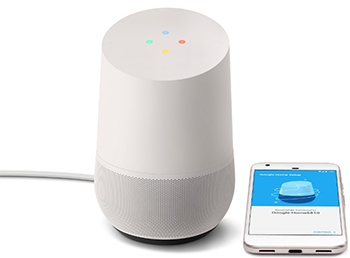Voice recognition software has come a long way in recent years, and is now a point of competition for major tech companies. Apple and Amazon have made waves with their Siri and Alexa platforms, making voice commands a central part of user experience on mobile devices and then in the home.
In 2016, Google jumped into the game with its Google Assistant. Initially exclusive to its Pixel and Pixel XL smartphones, and then only a feature on the Allo messaging app, the Google Assistant experience started simple. In 2017, however, Google Assistant continued to make strides, expanding to all Android devices and branching out from the Allo app into the full Android experience. Meanwhile, late in 2016, Google announced its Google Home devices, which are smart speakers designed to bring a voice assistant into the home, competing with Amazon’s popular Alexa line.

Google has clearly taken an interest in the voice command ecosystem, investing lots of resources and personnel into improving its Assistant and developing its personality and user experience. The results are clear: Google has caught up with Apple and Amazon, and is now a major player in the voice recognition game. Here’s a look at the impressive capabilities of Google Assistant.
Google Assistant: The essential guide
Where is Google Assistant?

Google Assistant is available on a range of devices – including Android smartphones and iPhones, speakers, Android Wear wearables, Google Pixelbooks, and Android TVs. Google’s Assistant SDK (software development kit) allows third-party developers to integrate Google Assistant into products and gadgets, so it’s likely that Google Assistant’s presence will continue to expand.
The best example of this is in the speaker category – Google Assistant is, of course, available on the Google Home line, a collection of speakers designed and sold by Google primarily for the purpose of putting Assistant in homes. However, Assistant is also available on speakers made by other companies – including Sony, Sonos, and JBL.
In other words, Google Assistant is everywhere. Most people in the market for a voice assistant carry a smartphone wherever they go – that alone enables Google Assistant to be along the ride. For users with multiple Google devices (or third-party devices with Google Assistant built in), the experience just gets more seamless.
So…. What exactly can it do?
Regardless of how easy it is to find devices that support Google Assistant, the big question is what it does – and whether that’s useful and intuitive enough for people to make it a part of their day-to-day routine. Google’s goal with many of its products – starting with its bread-and-butter, Google Search – is to build an experience that’s so simple and useful that almost everyone uses it regularly and very few people even bother to look at alternatives. It’s very likely that Google’s vision for Assistant is similar.
Local information
Google Assistant can help you get the lay of the land before you head out to start your day. You can ask Assistant to check the weather or see how much traffic to expect on your way to work. You can also search for locations and destinations nearby (for example, by asking where to get a cup of coffee), and you can ask for directions and have those directions sent to your phone.
You can also update your settings by voice command, and request that Google always deliver certain pieces of information in certain ways – such as changing your preferred temperature measurement to Celsius.
Productivity
One of the main roles for Google Assistant is to schedule tasks, set reminders, and help manage information to boost productivity and limit forgetfulness. You can ask Google Assistant to read off your schedule in the morning, and ask it to add or remove calendar events. With support for external apps, like Todoist, you can manage your lists and tasks that live outside the Google ecosystem.
Setting everyday reminders is one of the most useful features of Google Assistant. You can ask Assistant to remember where you parked, what you need to pick up at the grocery store, a phone number you need to call, and much more.
Home Control
Google Assistant can integrate seamlessly with smart home devices to adjust your thermostat, lock doors, turn indoor and outdoor lights on and off, and more. You’ll need to buy compatible devices to enable these capabilities, but they’re worth considering, as they can take the Google Assistant experience to an entirely new level.
The most wide-ranging of these devices might be a smart plug, like this
from TP Mini. With a smart plug and the Google Assistant, you can turn any electronic device on and off by voice command. This works great for lamps, fans, space heaters, and more. The Nest thermostat is another useful extension for Google Assistant – with a Nest, or another smart thermostat, you can adjust temperature room by room with voice commands. The possibilities to integrate smart home devices are nearly endless – there are devices and integrations for every room in the home, plus the yard and garage.
Communication
Google Assistant is chock full of capability when it comes to communications and messaging. You can have your emails and texts read to you, and fire off quick responses, all by voice. You can place calls, both to your contacts and to places around you (like a pizza restaurant or a flower shop).
News & Entertainment
This is another area where Google Assistant shines. You can ask Assistant to play music – your own playlists on Spotify or stations on Pandora, or a curated playlist or genre. Google Assistant will also keep up with your podcasts, and play the latest unplayed episodes or pick up where you left off, even between devices.
With multiple Google Assistant-enabled speakers, you can control playback and volume from room to room.
With a Chromecast device or an Assistant-enabled smart TV, you can ask Assistant to play a certain movie or show, or display photos or other media on the TV. You can ask to play YouTube videos, search for photos, and ask for movie and show recommendations.
News is another useful feature on Google Assistant. You can ask for a quick roundup of the news, or ask for updates from specific outlets, like CNN. You can also ask for stock updates, scores, trending topics, and more.
Dining
Aside from being able to ask for restaurant recommendations or locations, the Google Assistant offers a wide range of food functionality. It’s a great kitchen tool for chefs and bakers – you can ask for measurement conversions, recipe details, nutrition facts, and more. You can also ask how to make cocktails, or place takeout and delivery orders.
Health & Fitness
It’s often said that fitness begins in the kitchen, and if that’s true, then Google Assistant can be a great help, as detailed above. But its health and fitness contributions don’t end there. You can keep track of your caloric intake and water consumption, ask how much of a particular nutrient or vitamin you should be getting, and even measure your step count and heart rate, with certain devices.
Google Assistant can also be useful to keep track of runs and workouts. You can log your workouts, look up your history, and get an idea for your progress.
—
It’s difficult to put together an exhaustive list of all the capabilities of Google Assistant. The bottom line, though, is that Google is attempting to craft a ubiquitous and useful experience that’s like second nature – easy to turn to for specific tasks and for entertainment.
You can ask Google Assistant almost any question that can be answered on Google Search. You can use it to track your phone, play media, answer questions, settle bets, and even play games.

